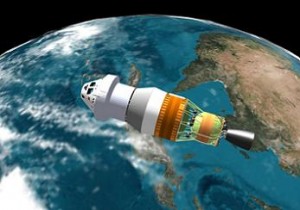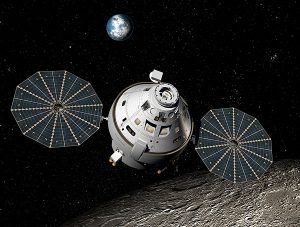According to Aviation Week, Lockheed Martin has discussed with NASA a test flight scenario for a human mission to Moon orbit by 2016. Lockheed Martin is completing development, test and production of the Orion Multi-Purpose Crew Vehicle (MPCV), the next generation NASA space capsule to be launched on top of the Space Launch System (SLS), an evolvable heavy lift rocket for deep space missions. On September 9, 2011, Lockheed Martin has started the production of the first space-bound orion capsule.
The Moon mission, which would utilize the 70 metric ton version of the SLS combined with a Boeing Delta 4 upper stage, would accelerate by five years the plans for the first human flight of Orion-MPCV. Laurence Price, Lockheed Martin’s Orion deputy program manager, said that the company is adapting the test scenarios to the SLS: “We already know a lot about this vehicle, its environment, load conditions and trajectory. So we are accommodating the unique capability of the launch vehicle into the design of the Orion/MPCV. We are already converging on how this vehicle will fly.”

Artist’s conception of the flight configuration for the 2014 Orion-MPCV test flight (Souce: Lockheed Martin).
NASA is already planning a unpiloted mission for 2013. The flight will take the Orion capsule up to an high Earth orbit, in order to test a step, high velocity reentry and verify the heat shield performance, the parachute deployment, and the descent and recovery operations. Lockheed Martin has already reserved a Delta 4 Heavy for this purpose. Later in 2014, a test for the Orion/MPCV’s Launch Abort System would follow. Launched from Kennedy Space Center on top of a Peacekeeper missile first-stage solid-fuel rocket motor, the capsule will reach a altitude of 15,000 m, allowing a test of the abort system guidance and navigation at maximum aerodynamic pressure. The abort system has already been tested successfully in a launch pad abort scenario in May 2010. Lockheed Martin would like then to proceed to a human mission to Lunar Orbit in 2016, following integration of testing results of the capsule with those of the SLS: “We are trying to collaborate with SLS,” said Price, “We are trying to find benefits for each to the maximum extent possible.”
























![A trajectory analysis that used a computational fluid dynamics approach to determine the likely position and velocity histories of the foam (Credits: NASA Ref [1] p61).](http://www.spacesafetymagazine.com/wp-content/uploads/2014/05/fluid-dynamics-trajectory-analysis-50x50.jpg)



Leave a Reply